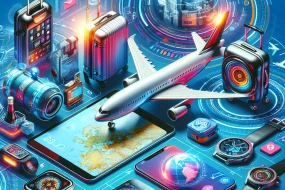
Traveling opens up a world of new experiences and cultural exchanges, and speaking the local language can enhance these experiences significantly. In our digital age, technology offers numerous tools to aid language learning, making it easier for travelers to communicate across borders. This article explores the best tech tools for language learning tailored specifically for travelers, offering practical insights and real-world examples to help you navigate linguistic landscapes with ease.
Why Language Learning Matters for Travelers
Imagine landing in a bustling Moroccan market, the air filled with vibrant sounds and scents, and you can exchange pleasantries in Arabic with a friendly vendor. Language learning for travelers isn't just about translation; it's about connecting on a human level. Understanding even a few words can transform a transactional exchange into a memorable interaction. While English might be widely spoken, making an effort to learn the local language often leads to richer experiences and deeper connections. It shows respect for the culture and can even open doors to hidden gems that guidebooks might not cover.
Top Tech Tools for Language Learning
With countless apps and online platforms available, choosing the right tool can be daunting. Here, we break down some of the most effective tech tools that travelers can use to learn languages efficiently.
1) **Duolingo**: Known for its gamified approach, Duolingo offers bite-sized lessons that are perfect for travelers on the go. With a wide range of languages and a user-friendly interface, it's a great starting point for beginners.
2) **Babbel**: This app focuses on practical conversation skills, making it ideal for travelers who want to learn phrases they can use immediately. Babbel's lessons are crafted by linguistic experts, ensuring a high-quality learning experience.
3) **Rosetta Stone**: A classic in the language learning world, Rosetta Stone uses immersive techniques to teach languages. It's particularly useful for auditory learners who benefit from listening and repeating phrases.
4) **Google Translate**: While not a learning tool per se, Google Translate is invaluable for travelers. It can instantly translate text, speech, and even text within images, making it a handy tool to have in your pocket.
5) **Pimsleur**: This audio-based program is perfect for travelers who prefer listening and speaking. Pimsleur is great for learning pronunciation and conversational skills, ideal for those long flights or train rides.
Navigating Common Pitfalls
While technology has made language learning more accessible, there are common mistakes travelers should avoid. One major pitfall is relying solely on translation apps. While they can be helpful, they often lack nuance and context. It's important to use them as a supplement rather than a crutch.
Another mistake is not practicing speaking enough. Language learning is as much about speaking as it is about understanding. Try to engage in conversations with native speakers whenever possible, even if it's just ordering coffee or asking for directions. Remember, making mistakes is part of the learning process, and most locals appreciate the effort.
Lastly, don't set unrealistic goals. It's unlikely you'll become fluent in a new language in a few weeks. Focus on learning key phrases and building a foundational understanding that can be expanded over time.
Integrating Language Learning into Travel Plans
Incorporating language learning into your travel plans can be both fun and rewarding. One effective strategy is to set daily language goals, such as learning five new words or phrases each day. Use idle time, like waiting in airports or during transit, to practice using language apps.
Engage with locals by participating in language exchange events or meetups. Websites like Meetup.com often list such events, providing an opportunity to practice in a social setting.
Also, consider staying in local accommodations like homestays or guesthouses where you can interact with hosts in their native language. This immersive experience can significantly boost your language skills and cultural understanding.
Conclusion: Embrace the Journey of Language Learning
Learning a new language is much like embarking on a journey. It requires patience, practice, and an open mind. As you prepare for your next adventure, remember that language learning is not just about words and grammar but about embracing new cultures and perspectives. Use technology as a tool to enhance your journey, and don't be afraid to make mistakes along the way. After all, the best travel stories often come from unexpected encounters and the courage to step outside your comfort zone.































